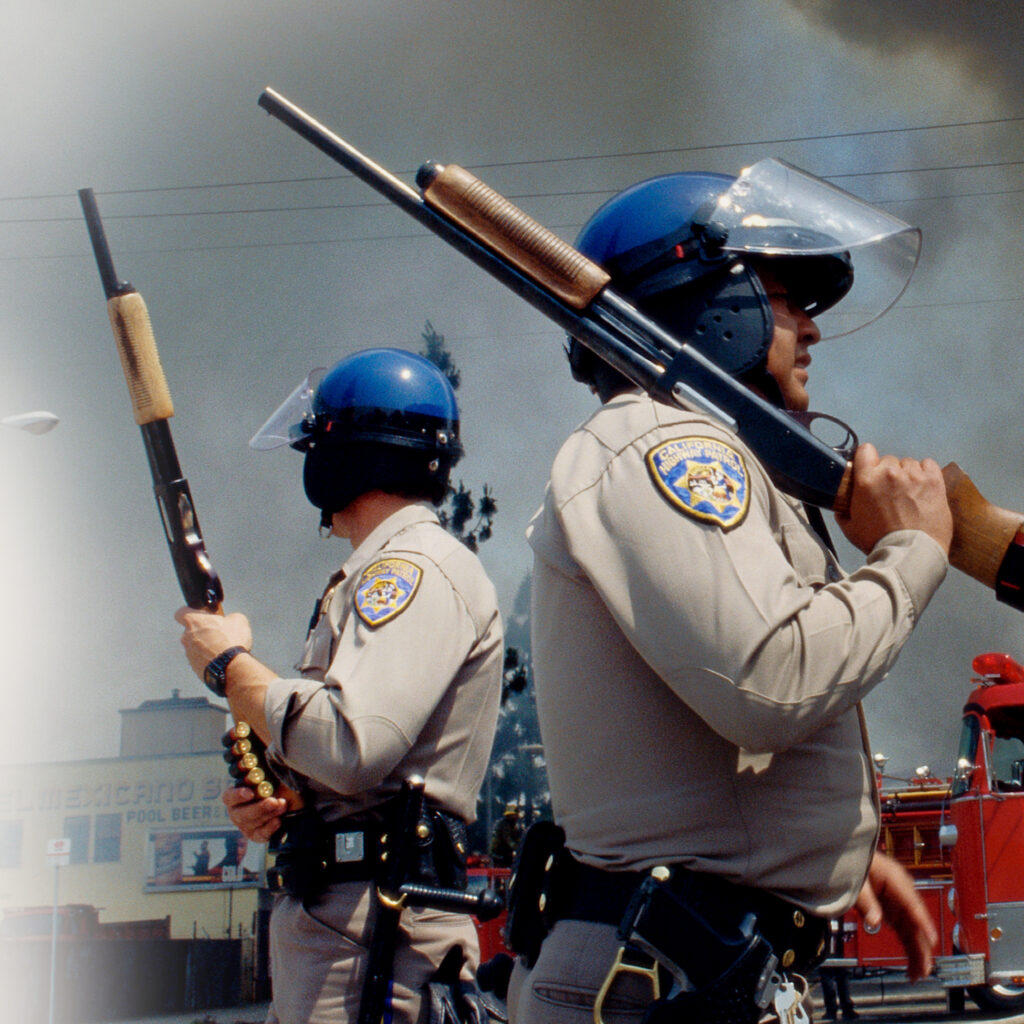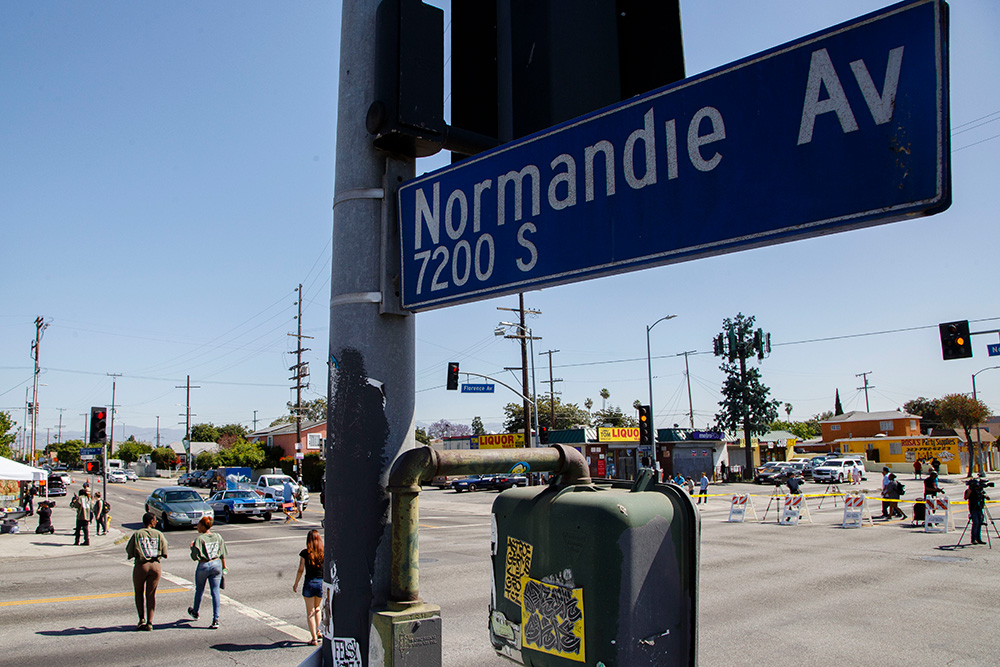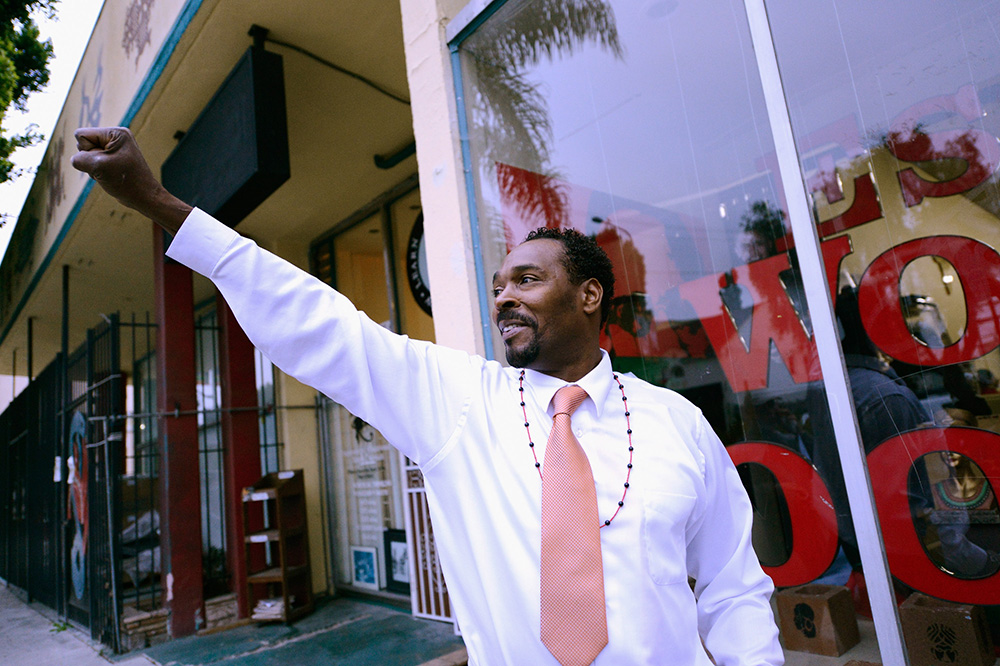 Bass and Beyond
Bass and Beyond
Filming the Proof
Discover how the West Coast became the region that put police brutality in the national spotlight, when citizen journalists used their camcorders and phones to capture and share powerful footage of injustice in real time. Their grassroots reporting challenged mainstream narratives, sparking crucial conversations about accountability and reform.
The viral video of Rodney King’s beating by Los Angeles police officers in 1991 became a defining moment in the city’s history, sparking national conversations about police brutality, racial inequality, and justice in America. This grainy footage, recorded by a bystander named George Holliday, captured the brutal beating of King by four officers after a high-speed chase. It laid bare a pattern of police misconduct that had long been reported by Black Angelenos but rarely believed by the broader public or the media. The impact of the video not only reverberated through Los Angeles but also changed the dynamics of race relations and police accountability across the country.
Rodney King: A Symbol of Struggle
On the night of March 3, 1991, LAPD officers stopped Rodney King, a Black motorist, after a high-speed pursuit. What happened next was recorded on the now-famous camcorder footage: officers repeatedly struck King with batons, kicked him, and used excessive force. King’s injuries were extensive, including skull fractures, 55 broken bones, and permanent brain damage. King became a central figure in the national conversation about police brutality, though he personally never sought the limelight.
Despite the trauma he endured, King repeatedly called for peace, especially in the aftermath of the unrest that followed the trial of the officers involved. His famous plea, “Can we all get along?” during the 1992 uprisings in Los Angeles, became an iconic expression of his hope for reconciliation, despite the injustice he faced. King’s life after the trial was marked by personal struggles, including battles with addiction and financial difficulties. He passed away in 2012, leaving behind a complex legacy as both a victim of police brutality and a voice for nonviolent resolution.
The Officers and Their Fate
The four officers charged in King’s beating – Stacey Koon, Laurence Powell, Timothy Wind, and Theodore Briseno—were initially acquitted by a predominantly white jury in Simi Valley, California, on April 29, 1992. The verdict ignited outrage and sparked one of the largest uprisings in U.S. history, as Los Angeles descended into chaos for five days. Thousands of people took to the streets, expressing their anger not only about the King case but also about the deep-seated racial and economic inequalities that had long plagued the city. During the unrest, over 50 people were killed, more than 2,000 were injured, and thousands of buildings were damaged or destroyed.
Following the uprisings, the federal government intervened. In 1993, two of the officers, Koon and Powell, were convicted in a federal trial on civil rights charges and sentenced to 30 months in prison. Wind and Briseno were acquitted again, further deepening the divide between the police and the Black community in Los Angeles.

A City Shaped by Uprisings
The Rodney King beating and the subsequent unrest forever changed Los Angeles. The city’s police department came under intense scrutiny, leading to calls for reform and accountability that would reshape law enforcement practices. While progress has been made, such as the implementation of civilian oversight and improved training for officers, many in Los Angeles and beyond still grapple with the same issues of racial inequality, police brutality, and economic disparity that fueled the 1992 uprisings.
Moreover, the King incident opened the eyes of the nation to the power of citizen journalism. The grainy footage captured by a bystander was one of the first instances of an ordinary citizen using a video camera to document police misconduct. It prefigured the rise of cellphone cameras and social media as tools for activism, a trend that would gain momentum in later years, especially during the Black Lives Matter movement.
Lora King’s Advocacy and the Second Draft Project
Lora King, Rodney King’s daughter, has continued her father’s legacy by working as an advocate for justice and police reform. She founded the Rodney King Foundation, an organization dedicated to promoting human dignity, civil rights, and healing communities through advocacy and support programs. Lora has expressed that while her father’s beating was highly publicized, the true depth of his story, including his humanity and struggles, has often been overlooked in the media.
In her role as the inaugural Interactive Interview for the Charlotta Bass Journalism & Justice Lab’s Second Draft Project, Lora King reflected on how her father’s story has been told—and in her view, not always correctly or fairly. The Second Draft Project aims to revisit stories that have been told through a mainstream lens and to give voice to those who feel their experiences were misrepresented or misunderstood. Lora’s participation in this project signals her desire to correct the narrative, emphasizing that her father’s legacy is not just one of victimization but also one of resilience and the pursuit of peace.
In her interview, Lora spoke about the lasting impact of her father’s beating and how the media often failed to capture the full picture of Rodney King as a person. She shared stories about her father’s kindness, his deep love for his family, and his desire to live a life of purpose. Lora’s involvement with the Bass Lab underscores the importance of giving individuals and their families the opportunity to reclaim their narratives, especially when those narratives have been shaped by trauma and media sensationalism.

A Legacy That Endures
The Rodney King incident and the ensuing unrest marked a turning point in Los Angeles, exposing the fractures in the city’s social fabric. Although reforms were implemented in the wake of the riots, the issues of police brutality and racial inequality remain challenges to this day. The story of Rodney King is a reminder of the long struggle for justice and the need for continued vigilance in holding law enforcement accountable.
Through the efforts of Lora King and projects like the Second Draft Project, there is a renewed focus on ensuring that stories of injustice are told with nuance, respect, and a deep understanding of the individuals involved. Rodney King’s story, and the story of Los Angeles in the aftermath of his beating, serves as a crucial chapter in the ongoing fight for racial equality and justice in America.
Moreover, Lora King’s decision to participate in this project is a testament to the power of storytelling as a tool for healing, remembrance, and advocacy. By revisiting her father’s story, she ensures that Rodney King’s legacy continues to inspire conversations about justice, fairness, and the enduring need for societal change.
The Oscar Grant Case: The First Viral Smartphone Video
Seventeen years after Rodney King’s beating, Oscar Grant’s death became the first viral instance of police brutality captured on a smartphone. On New Year’s Day 2009, Grant, a young Black man, was detained by transit police at Fruitvale Station in Oakland, California, after a fight was reported on a Bay Area Rapid Transit (BART) train. While Grant was lying face down on the platform, one of the officers, Johannes Mehserle, shot him in the back, killing him.
The key difference between this case and the Rodney King video was the technology used to capture it. By 2009, the smartphone era was in full swing, and multiple passengers on the train recorded the incident on their phones. Unlike Holliday’s camcorder footage, these smartphone videos were instantly shareable. Within hours of the shooting, the videos were posted online, and within days, they had spread across the globe, sparking protests and calls for justice.
Oscar Grant’s case marked the beginning of a new era in which viral videos of police brutality became a driving force in social justice movements. The immediacy of smartphones allowed witnesses to record incidents in real-time and share them without waiting for mainstream media to pick up the story. This decentralized the power of information dissemination, putting it into the hands of everyday people and transforming social media platforms into tools for activism.
The Impact of Video Evidence in Both Cases
In both the Rodney King and Oscar Grant cases, video evidence played a pivotal role in shaping public perception and responses to police violence. In King’s case, George Holliday’s video was broadcast on news stations nationwide, allowing people to see, many for the first time, the excessive force routinely used by police against Black men. The footage became a catalyst for protests and legal reforms, though the initial acquittal of the officers highlighted the limitations of video evidence in achieving immediate justice.
In Oscar Grant’s case, the viral spread of multiple smartphone videos led to widespread outrage and protests. Mehserle, the officer who shot Grant, was convicted of involuntary manslaughter, making it one of the few cases where a police officer was held criminally accountable for killing an unarmed Black man. However, the relatively light sentence—two years in prison—left many feeling that justice had not been fully served. The videos of Grant’s shooting helped galvanize the modern-day movement against police violence, which would find its full expression in the Black Lives Matter movement following the killings of Trayvon Martin in 2012 and Michael Brown in 2014.
A New Era of Citizen Journalism and Activism
The progression from George Holliday’s camcorder footage to the smartphone videos of Oscar Grant’s killing demonstrates the growing power of citizen journalism in exposing police brutality and mobilizing social movements. Holliday’s video was an anomaly at the time—a rare glimpse into the kind of violence that people of color had long faced in private. By the time Oscar Grant was killed, however, the presence of cameras had become more common, and the ability to capture and share videos had democratized the act of reporting.
The rise of smartphones and social media has made it nearly impossible for such incidents to go unnoticed. In the past, police violence might have been witnessed by only a few and dismissed by those in power. But now, with millions of people having the ability to record and share videos, there is a much greater chance that these injustices will be exposed and met with public outcry. This shift has placed new pressure on law enforcement agencies and judicial systems to hold officers accountable.
The videos of Rodney King and Oscar Grant have had a lasting impact on how the public views police brutality. While both cases highlighted the limitations of the legal system in addressing these issues—evident in the acquittals and light sentencing—the footage has played an instrumental role in shifting public opinion and inspiring activism. Today, smartphone videos of police brutality, such as the killings of Eric Garner, Philando Castile, and George Floyd, continue to fuel the movement for racial justice and police reform.
Conclusion
George Holliday’s video of Rodney King in 1991 and the viral smartphone footage of Oscar Grant in 2009 marked two critical moments in the evolving role of citizen journalism. Holliday’s camcorder footage was groundbreaking, bringing police brutality into the public eye for the first time on such a large scale. Oscar Grant’s killing, captured by smartphones, foreshadowed the era of viral video activism that now defines the fight for racial justice in America. Together, these videos underscore the power of technology in documenting injustice and the critical role that citizens play in holding systems of power accountable.
